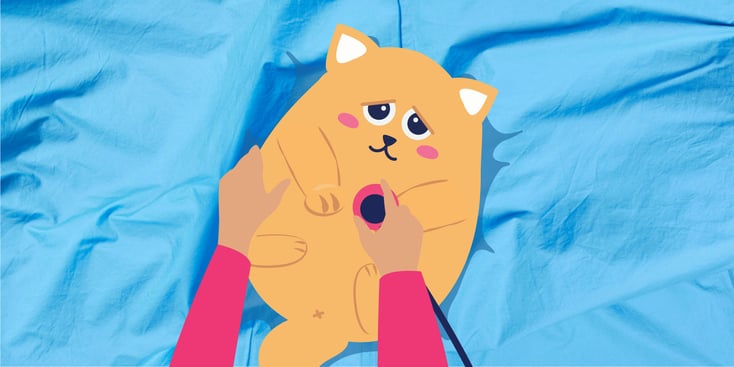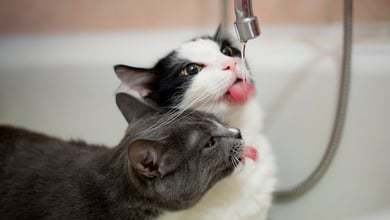10 Common Cat Diseases & What You Need to Do

Table of Contents
If you have one or more feline family members, you’ll want to make sure they’re as healthy as possible. But every pet gets sick sometimes, don’t they? Being aware of some common cat diseases can help you spot the signs of illness early. This is important because the sooner you notice your cat’s feeling unwell, the sooner you can get veterinary advice and get them on the road to recovery.
When it comes to cat diseases, the most common ones will depend on factors like the area where you live and your cat’s age, gender, and breed.
However, here are some diseases that are common among our feline friends:
1. Flea Allergic Dermatitis
If you’re the proud pet parent of a cat, then hopefully you treat them regularly for fleas. Fleas cause intensely itchy and irritating bites on cats, dogs, and humans. High numbers can also cause your cat to be anemic from all that blood-sucking! However, fleas cause another issue that’s more common than you might think, and that’s Flea Allergic Dermatitis (FAD), or flea allergy. FAD causes hair loss and scratching, and you might see red bumps or scabs on the skin.
Luckily, although it can be frustrating and time-consuming to get rid of fleas once they are in your home, these pesky parasites can be prevented. Regular flea prevention is key to treating flea allergies in your cat.
2. Hyperthyroidism
Hyperthyroidism is a disease that affects cats who are middle-aged or older. In this condition, the thyroid gland produces too much thyroid hormone, usually due to a goiter (thyroid enlargement or lump). High thyroid hormone levels speed up your cat’s metabolism, causing a racing heart rate, high blood pressure, and weight loss. So, if your purry OAP has lost a bit of weight recently or has a ravenous appetite, they might have hyperthyroidism. In the more advanced stages, hyperthyroidism can put extra strain on the heart and cause fluid to build up around the lungs, causing difficulty breathing.
A range of treatment options is available, including tablets, liquid medicine, a medicated gel, and a prescription diet. But, if you want to avoid giving life-long treatment to your feline friend, chat to your veterinarian about surgery to remove the gland or radioactive iodine therapy.
3. Kidney Disease
As your cat companion gets older, their body will start to age. In some areas, this aging process is visible – perhaps their fur will change color, they might not look so muscular, or their face shape might change a little. However, some age-related changes are invisible. One example of this is the kidneys. Kidney function will often decline with age, but that doesn’t mean your cat will immediately become unwell with kidney failure. As long as half of the kidney tissue is working correctly, they can pick up the slack. As more and more kidney tissue stops working, though, signs of kidney failure will develop.
Symptoms of kidney failure in cats include increased thirst, passing urine more frequently, weight loss, and vomiting. You might also notice that your puss doesn’t have the appetite they once had. Sadly, nothing can be done to repair the kidneys when they fail. Still, a prescription diet and supportive care can help your cat cope for as long as possible.
4. Cat Flu
Cat flu is caused by various viruses and bacteria, including Herpesvirus, Calicivirus, and Bordetella bronchiseptica. It is very common in young kittens but can affect cats of any age. It causes sore and gunky eyes, sneezing, and nasal discharge. Very young kittens with cat flu often stop feeding and become weak and dehydrated. Sadly, in these cases, it’s sometimes fatal.
Cats with the flu can be supported with antibiotics and sometimes need fluids via a drip, but there is no specific treatment. Once a cat has had cat flu once, it can get regular flare-ups throughout their lives, especially at times of stress. The best way to prevent your cat from getting cat flu is to make sure they are vaccinated.
5. Worms
A few different types of worms can affect your cat, including tapeworms and roundworms. These worms live in your cat’s gut and can cause diarrhea, vomiting, and weight loss. They’re especially common in cats who do a lot of hunting. If your furry friend has a lot of these “visitors,” you might spot them in their poop or their vomit – yuck! You can keep your cat free from worms by using a veterinary-approved worming product regularly.
6. Cancer
Just like humans, cancer affects cats too. Cancer occurs when cells in the body replicate uncontrollably, often leading to tumors. Different types of cancers affect different parts of the body. Therefore, the symptoms can vary drastically, from just a visible lump on your cat to weight loss, weakness, coughing, vomiting, diarrhea, and many more. So, if you find a lump on your cat, or if you’re concerned that they’re not their usual self, get them booked in for a check-up with the veterinarian.
7. Diabetes
Diabetes isn’t just a human condition; cats and dogs can get it too! If your cat has diabetes, its pancreas won’t produce enough insulin to lower its blood sugar. You might notice that they’re excessively thirsty and pee a lot, and they might also lose weight. When their blood sugar is persistently high, it can lead to a condition called ketoacidosis, which causes vomiting, weakness, and dehydration and is life-threatening.
One of the main risk factors for diabetes is obesity, so keeping your cat nice and trim will help to avoid this condition. Diabetes is usually treated with insulin injections and strict diet management. However, tablets to lower blood sugar can sometimes be effective.
1. Has your dog experienced rapid weight loss?
2. Has your dog’s appetite increased or decreased?
3. Is your dog more thirsty than usual?
4. Is your dog urinating more frequently than usual?
5. Is your dog less active than usual?
6. Does your dog have cloudy eyes or is experiencing vision problems?
7. Is your dog experiencing frequent urinary tract infections?
8. Does your dog have sweet-smelling breath?
9. Does your dog seem more lethargic than usual?
10. Does your dog have a family history of diabetes?
11. Is your dog's coat dull or thinning?
12. Has your dog had frequent skin infections?
1. Is your cat urinating more frequently than usual?
2. Is your cat more thirsty than usual?
3. Has your cat experienced rapid weight loss?
4. Is your cat showing signs of muscle weakness?
5. Has your cat’s appetite increased or decreased?
6. Does your cat seem more lethargic than usual?
7. Is your cat vomiting more than usual?
View Results
8. Obesity
You might not realize it, but one of the most common diseases in cats is obesity. If you have a pudgy pet, the extra pounds will be putting strain on their heart and joints and can sometimes make it harder for them to breathe. They’ll also be more at risk of developing diabetes. If you’re worried that your cat might need to lose some weight, speak to our veterinary team about how we can lend help and support.
9. Cystitis/Urinary Tract Disease
If your pet is popping back and forth to the litter box every few minutes and is straining or passing blood in their urine, they probably have a urinary tract disease. Cystitis, which is inflammation of the bladder lining, is very common in cats and can be caused by stress. Male cats are especially prone to getting a blocked bladder, where their urethra becomes obstructed by a small bladder stone.
A blocked bladder is an emergency, as it can cause permanent kidney damage, bladder rupture, and even death. Many cats who are prone to problems peeing can be improved with supplements and measures to reduce stress. As always, speak to your veterinarian if you are concerned.
10. Dental Disease
Dental disease is by far the most common disease among cats. Most cats who are middle-aged or older will have at least some plaque or tartar on their teeth, with many older cats losing teeth due to decay. As well as plaque and tartar-causing bacteria build-up and tooth loss, cats are also affected by a unique condition called Feline Odontoclastic Resorptive Lesions (FORL). This is when the outer layer of the tooth root is resorbed, causing painful holes in the tooth where the nerve is exposed. Your veterinarian will check your cat’s teeth regularly in case they need a scale and polish or tooth extraction.
The best way to keep your cat’s pearly whites in tip-top shape is to brush their teeth regularly. Still, there are other helpful products like antibacterial gels and rinses and specialist dental diets.
Summary
Now you know some of the most common cat diseases, you can work on preventing them in your cat. Of course, some conditions are unavoidable no matter what you do. Knowing the symptoms to look out for will help you recognize when your cat is unwell and get the veterinary help they need to get them on the mend!






